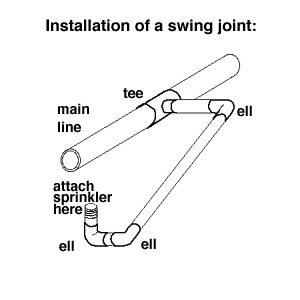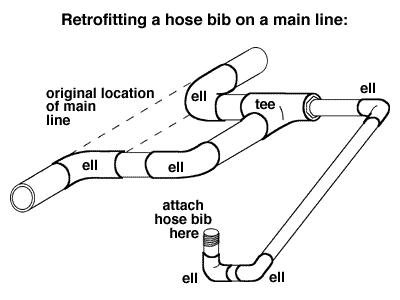Sprinkler System Tips and Tricks
Here are some tips and tricks that will help you design
and install your sprinkler system. If you know of any hints that you think
should be included here, .
Low branches
Need to clear low hanging branches when using rotors?
Install low angle nozzles, such as available in the Hunter PGP sprinklers
and the spray pattern will be lowered considerably with only a slight reduction
in radius.
Funny angle fittings needed?
Having trouble finding the right elbow? Need one that
is between 45 degrees and 90 degrees, or one sharper than 90 degrees? Just
combine two elbows with a short section of pipe in between. By rotating
the elbows, you can achieve any desired angle.
Replacing a sprinkler the lazy (and wet) way.
To replace the head you need to unscrew the head from the pipe and screw the new one on. Normally people dig a hole down to the pipe to make this kind of repair, but if you're careful, you can close your sprinkler system main shut-off valve most of the way off and then turn on the station with the bad head. While the water is slowly running out of the heads, you can unscrew the bad head and screw on the new one. You'll have to pay attention to whether the nipple that attaches the old head to the pipe comes off with the old sprinkler head, or if you're lucky it will stay on the pipe below, and all you have to do is screw the new lower body (with inner mechanism removed beforehand). After the water flushes through the lower body of the sprinkler the dirt will be cleared out, and you can insert the new mechanism into the body and get it adjusted.
 Adjusting sprinkler heights
Adjusting sprinkler heights
Having trouble getting the pipe set at the right height
for the sprinklers you are using? Install a "swing joint"! Just
install a tee (side outlet pointing horizontally) in the pipe, then an elbow.
In that elbow, glue a foot long piece of pipe, another elbow, then another
elbow to screw the sprinkler into as shown in the figure above. By adjusting
the first two elbows, you can change the angle of the foot long swing joint,
allowing you to adjust the height of the sprinkler to whatever you need.
|
Changing height of shrub sprinklers
Having trouble with the sprinklers clearing the shrubs?
Try installing a 12 inch pop-up. With one of these, the sprinkler will retract
flush to the ground, but can reach 12 inches into the air. Or, you can install
a 6 inch riser extension between the sprinkler and the nozzle. It will stick
out of the ground the whole time, but may solve your problem. One customer
of ours uses the standard pop-up during the cold season when the plants
are trimmed back, then he adds as many 6 inch extensions as needed to keep
the sprinklers above the plants as they grow higher during the spring and
summer. Since the extensions are hidden by the shrubs when they are installed,
they are not unsightly.
Install an outdoor faucet
Some people like to have faucets in the yard, especially
in places far from the house where the hoses are hard to reach. You may
want to wash your car or hand water a very small area that needs special
attention without having to water an entire section. Hose bibs are easy
to add during the original installation or later by following this hint.
Be sure to install the hose bib after the backflow preventer and use a 10
inch round box in the ground to protect it from damage. |
 |
Connecting to an existing pipe
Inserting a fitting into an existing pipe is tough
unless you use this trick. The hard way is to simply dig up a long stretch
of pipe so you can bend it around enough to insert it into the new tee,
giving you a side connection to work with. Since you have to remove a piece
much shorter than the overall length of the fitting you are inserting (you
need some overlap on both ends for gluing) you will have to dig up a lot
of pipe, especially if the line you are connecting to is large. You could
use a "slip fit" fitting, which can expand after you insert it,
or you can use a few standard elbows to accomplish the same job. We prefer
the last approach because we like hard glued fittings to "slip-fits".
We believe they are more reliable, especially on main lines that may be
pressurized at all times. By inserting three ells and one tee, you can obtain
a connection to the original line as shown above in the drawing on how to
retrofit a hose bib on an existing line. The same idea can be used to add
a sprinkler to an existing line.
Auto fill for pool or water garden
Set aside one station for filling your pool or water
garden at regular intervals, or even your pet's water bowl! Be sure you
are aware of how much you need to add so you don't overdo it. If that station
is on the same program as the lawn, it will receive more or less the right
amount of water as you seasonally adjust the program interval to accommodate
hotter/dryer and cooler/wetter weather.
Prevent damage to sprinklers due to vehicle traffic
If you have to install sprinklers in a location where
cars, trucks or trailers will travel, be sure to install them on swing joints
or at the end of a pipe instead of installing them in the middle of a pipe.
Since sprinklers installed on the ends of pipe have some freedom of movement,
there is less chance of breaking the pipe if a car runs over the sprinkler.
In addition, you can install cement rings (these look like cement doughnuts)
around the sprinklers. Another option would be to install a large diameter
(4 or 6 inch) thick wall PVC pipe around each sprinkler. the idea is for
the car wheel to bear weight on the pipe or ring surrounding the sprinkler,
instead of expecting the sprinkler and water line to bear the load. In the
worst case, if the pipe holding the sprinkler breaks, it's much easier to
repair the end of a pipe than to repair a section in the middle of a long
pipe.
Make provisions for future expansion
Due to future landscaping plans, you may need to move
a few sprinklers, or a valve. You may also want to divide a station into
two parts to obtain more control over one station that may have different
watering needs in different parts of the station. To provide for relocating
or adding valves, run an extra red wire or two the entire distance of the
main line. If you know where the future valve will be needed, run the wire
only to that point. If you know you will need to add a pipe later, insert
a tee in the line when you install the system, then glue a short piece of
pipe with a cap on it into the tee. Later you can cut the cap off and connect
to the end of that pipe. These steps will make it much easier to
add onto or modify the system later.
Trimming grass from sprinklers
In the spring, trim the grass from around your sprinklers.
Use a #2 can, twisting it back and forth like a cookie-cutter around each
sprinkler. It may help to cut the rim off the can with some tin snips, and
to give the cutting end a slight wavy shape. Leave the bottom on the can
for strength, and grab the can from the bottom end using gloves to protect
your hand.
Copyright ©1995-2012 by Travis Irrigation Plans & Supply. All rights reserved. Reproduction in whole or in part in any form or medium without express written permission is prohibited.
Read our important legal as well as our privacy and security information.
Travis Irrigation Plans & Supply, Austin, Texas
|
|





 Adjusting sprinkler heights
Adjusting sprinkler heights
